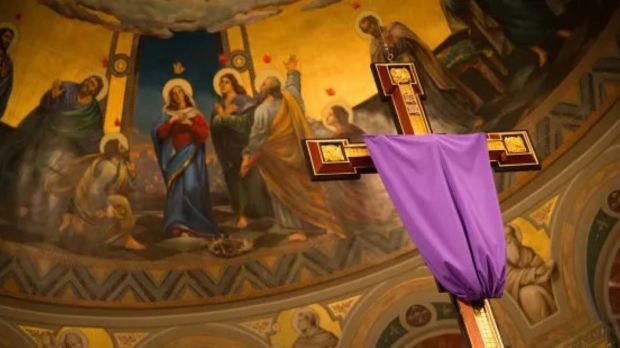Holy Week hits harder than ever for me, it seems — and I bet it does for you, also — and I think I know why.
I think it’s because we remember 2019 and 2020.
The year 2019 taught us not to take the external symbols of our Church for granted.
That was the year the Cathedral of Notre Dame began burning on the Monday of Holy Week. People cried in the streets of Paris, and watching the news around the world.
Seeing the iconic church burn was like a parable of what happens when we neglect our faith — and a reminder that Jesus Christ himself, and not expressions of our faith, is at the center of our faith.
And then came the emptiness of Holy Week 2020.
When Palm Sunday came on April 5, 2020, worldwide lockdowns to try to stop the Covid-19 pandemic had already begun.
Rome’s Colosseum stood empty with no Way of the Cross, no Via Dolorosa crowded the streets of Jerusalem, and no hooded figures appeared in the streets of Seville.
These painful memories remind us that our Holy Week sets Christianity apart from every other major religion.
The more than 40 days of Lent is the longest penitential season of any major religion, and it culminates in a week like no other.
That’s because, like Lent, Holy Week doesn’t so much commemorate what Jesus did, as relive what Jesus did. The priest prays, “united with him in his suffering on the cross, may we share in his resurrection and new life,” and since he is God, outside of time, he makes that possible.
Because of 2019 and 2020, I cherish the strange and singular once-in-a-year practices of Holy Week more than ever.
There are so many: The shrouded statues, the palms, the Gospel with multiple readers; foot wash-ees to coordinate with basin and towels and chairs; altar servers clacking instead of ringing and processing backwards with incense; and the Easter Vigil’s cantor and candles and candidates.
There is also the once-a-year music: the haunting Stabat Mater, the profoundly simple Negro spiritual “Were You There?” and the magnificent Exsultet.
Holy Week works if you do the minimum, or the maximum.
If all you do is participate in the two Sunday Mases and the mandatory fast on Good Friday, Holy Week is an immersive experience: You hear the whole Passion story, suffer with Christ, and end with Easter joy.
If you enter into everything the liturgy has to offer, you get reenactments of the foot washing and institution of the Eucharist, join the Gethsemane vigil and Way of the Cross; you venerate the Cross and take the Easter Vigil tour of salvation history.
But then, the actions of Jesus Christ during Holy Week are one of a kind.
In the ancient world, slaves were persona non grata, and so it changed the world when Jesus Christ, “emptied himself, taking the form of a slave.”
Nothing could be more unexpected — except that he would also “be obedient unto death, even death on a cross,” or that he would offer his very body and blood in a new covenant with his followers.
And then the Resurrection — the actual historic event of Jesus rising from his tomb — founded the largest faith in the world, in a radical departure from every other religious or philosophical system.
It is this that gave us hope in 2019, in 2020, and for all time.
Even 2019 and 2020 had unique images of hope. We all remember when the Crown of Thorns relic was almost miraculously rescued from Notre Dame. And we’ll never forget when Pope Francis delivered a March 27 Urbi et Orbi blessing in the rain in an empty St. Peter’s Square, but with all of us there.
Jesus Christ’s power transcended the fire, the pandemic, and transcends death itself. That is what we are celebrating each Holy Week.


